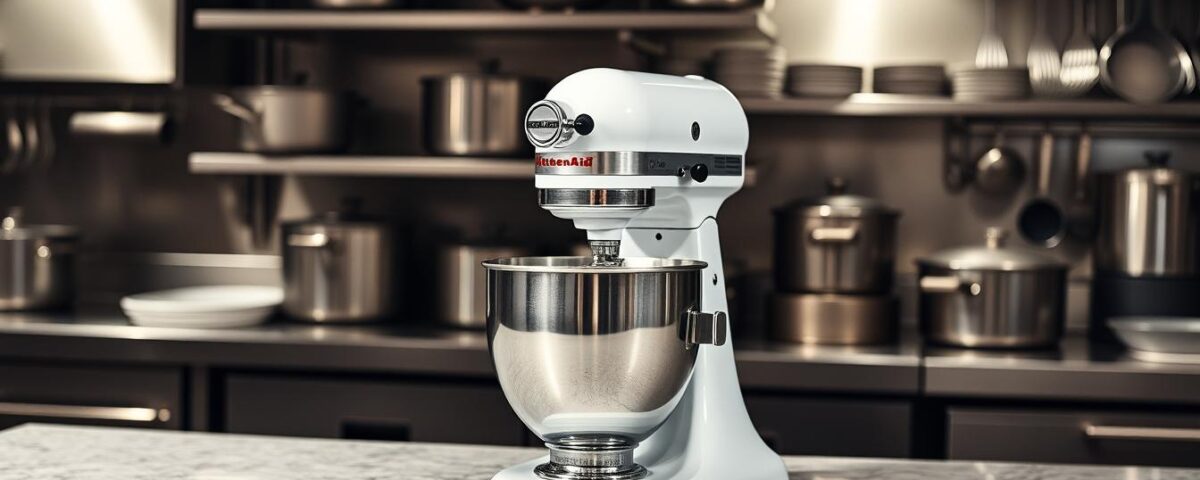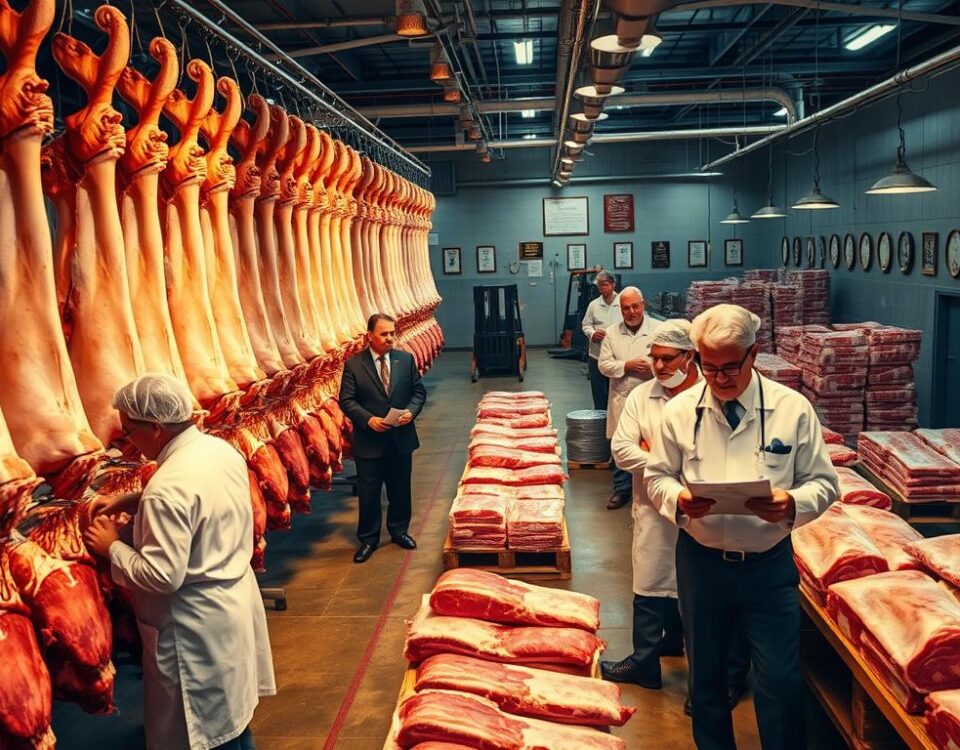
After Testing 5 Heavy-Duty Dough Mixers, This One Surprised Me
September 5, 2025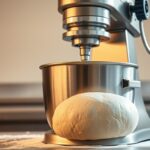
Spiral vs Planetary Mixer: Which One Yields Better Dough?
September 6, 2025I still remember the day a local bakery owner told me about the game-changing impact of incorporating a KitchenAid stand mixer into their commercial kitchen. The efficiency and versatility it brought to their food preparation process were nothing short of remarkable.
Did you know that many top chefs and bakers in renowned restaurants swear by their KitchenAid mixers for preparing everything from delicate pastries to hearty dough? With the global food industry projected to continue growing, the demand for efficient and reliable kitchen equipment is on the rise.
As a restaurant owner or chef, understanding the ins and outs of using a KitchenAid stand mixer in your commercial kitchen can be a crucial step in staying ahead of the curve. What do you need to know before making the investment?
Key Takeaways
- Understand the differences between home and commercial KitchenAid models.
- Evaluate the versatility and potential menu expansion possibilities.
- Consider space efficiency and workflow optimization.
- Assess the durability and reliability of KitchenAid equipment.
- Learn how to properly maintain and care for your KitchenAid mixer.
The Versatility of KitchenAid Stand Mixers in Commercial Settings
In commercial kitchens, the versatility of a KitchenAid stand mixer extends far beyond just mixing dough. With a powerful, high-speed motor and a wide range of accessories and attachments, this appliance can perform multiple tasks, making it an invaluable asset for restaurants.
Beyond Basic Mixing: Multi-Functional Applications
A KitchenAid stand mixer is not just limited to mixing; it can also be used to grind meat, shred chicken, slice, dice, and spiralize vegetables, thanks to its various attachments. This multi-functionality allows restaurants to prepare a variety of dishes using a single appliance, streamlining their food preparation processes. For instance, the ability to quickly swap attachments enables efficient use of counter space while maintaining food preparation versatility throughout service periods.
The variety of tasks that a KitchenAid stand mixer can perform makes it an essential tool in commercial kitchens. By using this appliance, restaurants can simplify their kitchen operations and increase productivity. Whether it’s preparing dough for bread, whipping cream for desserts, or shredding chicken for salads, the KitchenAid stand mixer is a valuable addition to any commercial kitchen.
| Task | Attachment | Benefit |
|---|---|---|
| Grinding Meat | Meat Grinder Attachment | Prepares meat for burgers or sausages |
| Shredding Chicken | Food Grinder Attachment | Simplifies salad or sandwich preparation |
| Slicing Vegetables | Food Slicer Attachment | Prepares vegetables for salads or sides |
Commercial Kitchen Space Optimization
One of the significant advantages of using a KitchenAid stand mixer in a commercial kitchen is its ability to optimize limited space. By replacing multiple single-purpose appliances with one versatile machine and its attachments, restaurants can free up valuable kitchen space. Strategic placement of the mixer in the kitchen layout can also maximize workflow efficiency and minimize movement between stations.
Creating dedicated workstations around the KitchenAid mixer can further enhance its utility in commercial kitchen environments. This approach not only streamlines food preparation but also contributes to a more organized and efficient kitchen operation.
Commercial vs. Home Models: Making the Right Choice
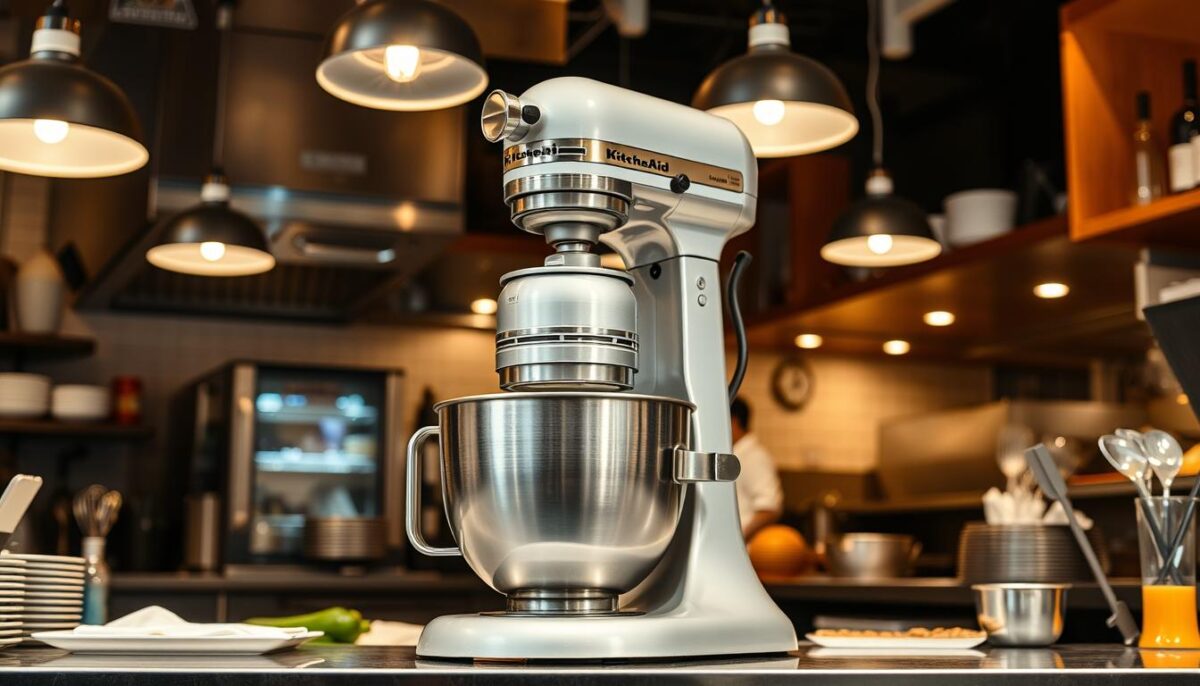
When deciding on a KitchenAid stand mixer for your restaurant, understanding the differences between commercial and home models is crucial. The right choice can significantly impact your kitchen’s efficiency and productivity.
Power and Capacity Considerations
Commercial KitchenAid stand mixers are designed to handle demanding tasks and large quantities of ingredients, making them ideal for high-volume kitchens. Unlike home models, commercial mixers offer more power and larger capacity bowls, enabling your team to prepare bigger batches of dough, batter, or other mixtures efficiently.
The increased power also means that commercial models can handle thicker, heavier mixtures without straining the motor, a common issue with home models when used extensively.
Durability Features for High-Volume Use
One of the key differences between commercial and home KitchenAid models lies in their construction and durability features. Commercial models are built with heavy-duty components, including metal gearing and reinforced parts, to withstand the rigors of constant use in a fast-paced kitchen environment.
Additionally, commercial models often come equipped with thermal protection systems to prevent motor burnout during extended operation periods. This feature is particularly important in restaurant settings where mixers are used frequently and for prolonged periods.
In conclusion, when choosing a KitchenAid stand mixer for your restaurant, it’s essential to consider the power, capacity, and durability features that distinguish commercial models from their home counterparts. By doing so, you can ensure that your kitchen is equipped with the right tools to meet your operational demands.
Essential KitchenAid Attachments for Restaurant Kitchens
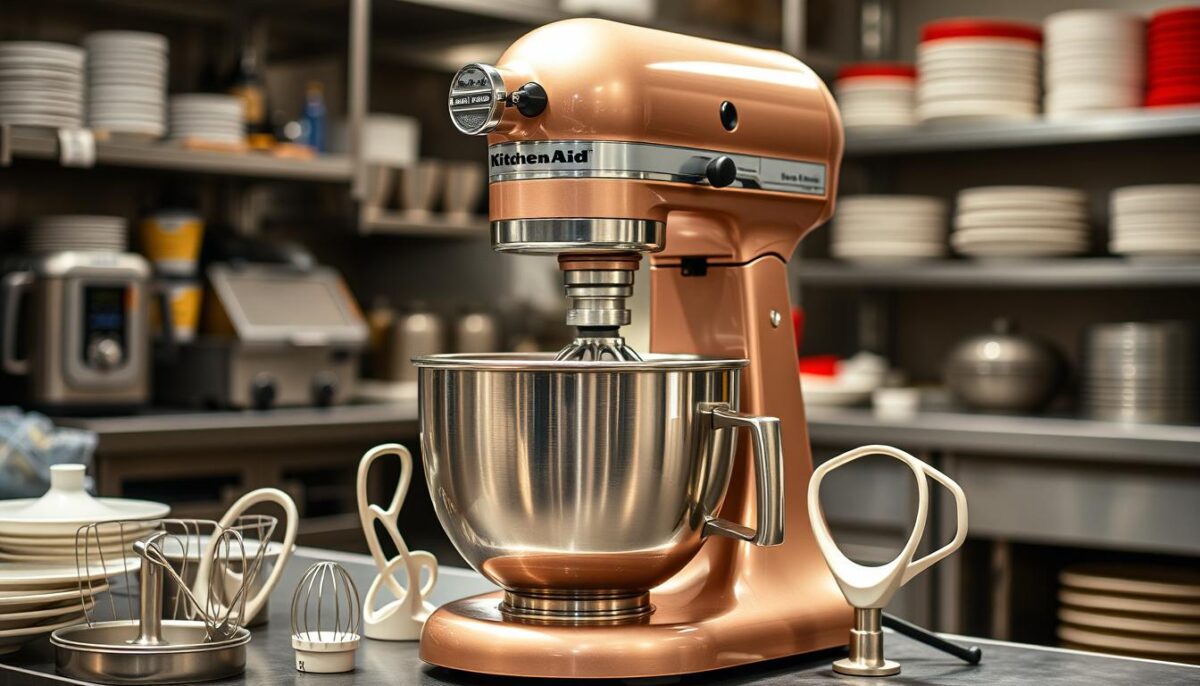
The right KitchenAid attachments can transform a stand mixer into a multifaceted kitchen workhorse, ideal for the demands of a restaurant environment. By expanding the capabilities of their stand mixers, restaurants can improve efficiency, expand their menu offerings, and enhance the overall quality of their dishes.
Time-Saving Attachments for Food Prep
Time-saving is crucial in a fast-paced restaurant kitchen. Attachments like the 6.9 L Dough Hook accessory are indispensable for mixing and forming dough, while the Pasta Sheet Roller Attachment simplifies the process of creating thin, uniform pasta sheets. These attachments not only save time but also ensure consistency in food preparation.
For restaurants looking to optimize their food prep processes, investing in the right attachments can make a significant difference. The KitchenAid® 5-Piece Pasta Deluxe Set allows for the creation of various pasta types, from spaghetti to fettuccine, enhancing menu versatility.
Specialty Attachments for Menu Expansion
Specialty attachments can elevate a restaurant’s menu by enabling the creation of unique dishes. For instance, the Ice Cream Maker attachment allows restaurants to offer house-made frozen desserts without the need for dedicated ice cream equipment. Similarly, the Grain Mill attachment enables the creation of signature flour blends for artisanal breads and pasta, adding a marketing edge with “house-milled” menu descriptions.
Other attachments like the Sausage Stuffer Kit and Juicer attachment can support charcuterie programs and fresh juice offerings, respectively. These not only expand menu options but also provide opportunities for differentiation in a competitive market.
Kitchenaid Use in Restaurants: Best Practices and Techniques
Effective KitchenAid use in restaurants requires a combination of proper technique, staff training, and equipment maintenance. To get the most out of these versatile stand mixers, it’s essential to understand how to maximize efficiency in high-volume operations and train staff on proper equipment use.
Maximizing Efficiency in High-Volume Operations
To optimize KitchenAid mixer performance during busy service periods, consider implementing the following strategies:
- Pre-prepare ingredients to minimize downtime and ensure smooth operation.
- Utilize the correct mixer attachment for the task at hand to reduce processing time.
- Maintain a consistent workflow by staggering mixer use across different stations.
By implementing these strategies, restaurants can significantly enhance their food preparation processes, allowing for faster service and improved consistency in dishes.
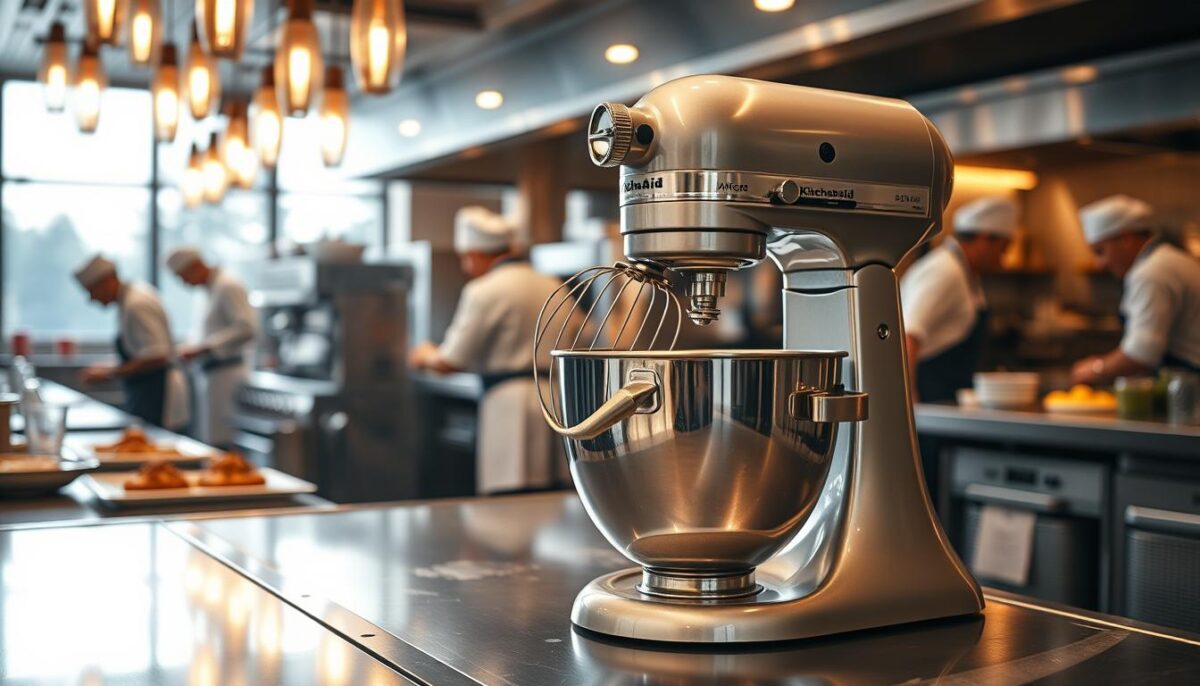
Training Staff on Proper Equipment Use
Comprehensive training is crucial for ensuring that staff members can effectively operate KitchenAid mixers. Key areas to focus on include:
- Speed selection: Teach staff how to choose the appropriate speed for different mixing tasks.
- Attachment changes: Train staff on safe and efficient attachment swapping procedures.
- Safety protocols: Emphasize the importance of following safety guidelines when operating the mixer.
Additionally, training staff on proper ingredient loading techniques can prevent common mistakes like flour clouds and splashing, which waste ingredients and time. By cross-training multiple staff members on mixer operation, restaurants can ensure that production continues smoothly regardless of who is working a particular shift.
By implementing these best practices and techniques, restaurants can maximize the benefits of using KitchenAid stand mixers, enhancing their overall kitchen efficiency and food quality.
Maintenance and Cleaning Protocols for Commercial Use
To ensure your KitchenAid stand mixer continues to perform optimally, regular maintenance and cleaning are essential. In a commercial kitchen, this equipment is subjected to heavy use, making a structured maintenance protocol crucial.
Daily Cleaning Requirements
Daily cleaning is the first step in maintaining your KitchenAid stand mixer. After each use, the bowl and attachments should be washed thoroughly. Use mild soap and warm water to clean these parts, and dry them completely to prevent any water spots or bacterial growth.
- Wipe down the mixer’s exterior with a damp cloth to remove any splatters or spills.
- Clean the mixer’s head and bowl lift area to prevent the buildup of debris.
Preventative Maintenance Schedule
A preventative maintenance schedule is vital for the longevity of your KitchenAid stand mixer. Here’s a basic outline:
| Frequency | Maintenance Task |
|---|---|
| Daily | Clean the mixer and its attachments |
| Weekly | Lubricate the gears according to the manufacturer’s instructions |
| Monthly | Check for worn or damaged parts and replace as necessary |
| Quarterly | Have a professional inspect and service the mixer |
By following this schedule, you can identify potential issues early and prevent equipment failure during critical service periods. Proper maintenance record-keeping is also essential, as it can extend the equipment’s lifespan and may be required for warranty claims.
Cost Analysis: Investment vs. Return for Restaurants
When considering the integration of a KitchenAid stand mixer into a restaurant, it’s crucial to weigh the initial investment against the potential return. This analysis involves understanding both the upfront costs and the long-term benefits that such equipment can bring to a commercial kitchen.
Initial Investment Considerations
The initial cost of a KitchenAid stand mixer and its attachments is a significant factor. While the mixer itself is a considerable investment, the range of available attachments can enhance its functionality, potentially justifying a higher upfront cost. Restaurants must consider the cost of the mixer, additional attachments, and any necessary training for staff.
A detailed breakdown of the initial investment is as follows:
| Item | Cost |
|---|---|
| KitchenAid Stand Mixer | $200-$500 |
| Attachments (average cost) | $50-$100 each |
| Staff Training | $100-$300 |
Long-Term Value and Labor Savings
The long-term value of a KitchenAid stand mixer lies in its ability to reduce labor costs and improve the quality of menu items. By automating tasks such as mixing and kneading, restaurants can significantly cut down on prep time, allowing staff to focus on other critical tasks. Moreover, the consistency provided by the mixer can enhance the overall quality of dishes, potentially leading to increased customer satisfaction and loyalty.
Some key benefits include:
- Reduced labor costs through automation
- Improved consistency in menu items
- Potential for menu expansion using various stand mixer attachments
- Increased profit margins through in-house production of ingredients
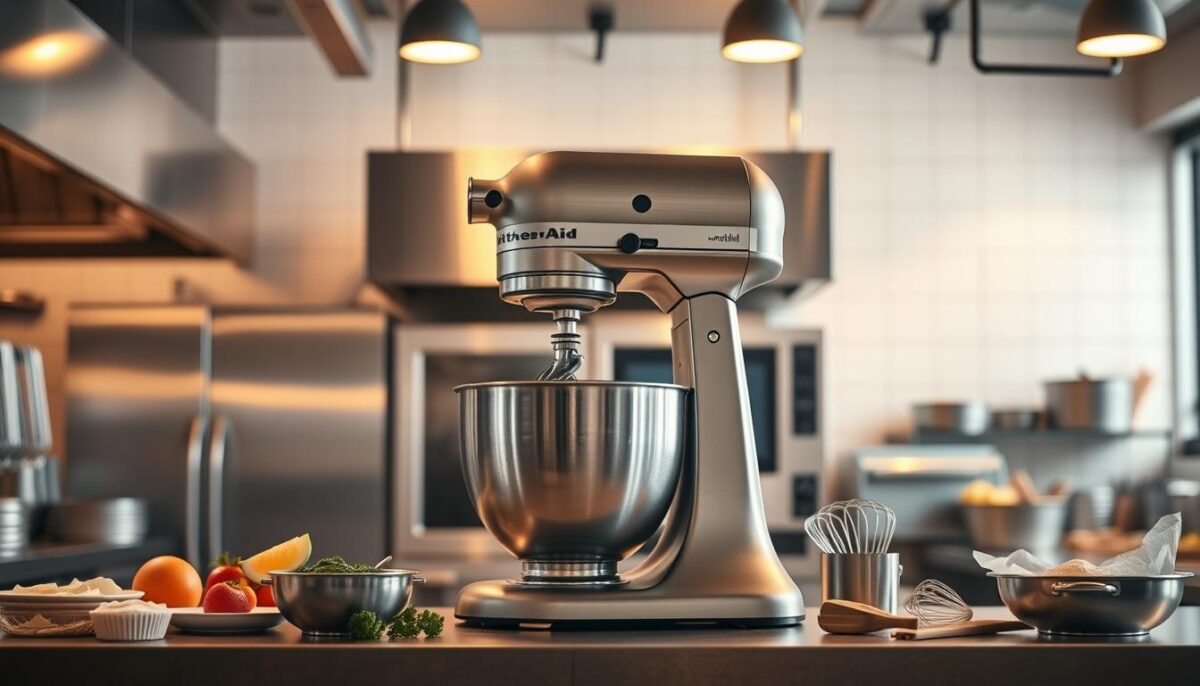
By carefully considering both the initial investment and the long-term benefits, restaurants can make an informed decision about whether a KitchenAid stand mixer is a worthwhile investment for their business.
Menu Innovation: Expanding Your Offerings with KitchenAid
By leveraging KitchenAid’s capabilities, restaurants can create unique and captivating menu items that drive customer interest and loyalty. The versatility of KitchenAid stand mixers allows chefs to experiment with a wide range of ingredients and techniques, from artisanal bread to intricate desserts.
Bread and Pastry Program Development
Developing a robust bread and pastry program can be a significant differentiator for restaurants. With a KitchenAid stand mixer, chefs can efficiently produce high-quality bread, pastries, and other baked goods. The mixer’s ability to handle large batches and heavy dough makes it an indispensable tool for creating artisanal breads and pastries that customers crave.
Using the KitchenAid stand mixer, restaurants can expand their offerings to include freshly baked bread and pastries, enhancing their menu and attracting customers looking for authentic, high-quality baked goods.
Specialty Items That Drive Customer Interest
KitchenAid attachments enable restaurants to create a variety of specialty items that drive customer interest and social media attention. For instance, the KitchenAid® Ice Cream Maker Attachment allows restaurants to make unique ice cream flavors, such as lavender and honey or Thai tea ice cream. Similarly, the Pasta Maker Attachment enables the creation of fresh, house-made pasta dishes that can be tailored to seasonal ingredients and customer preferences.
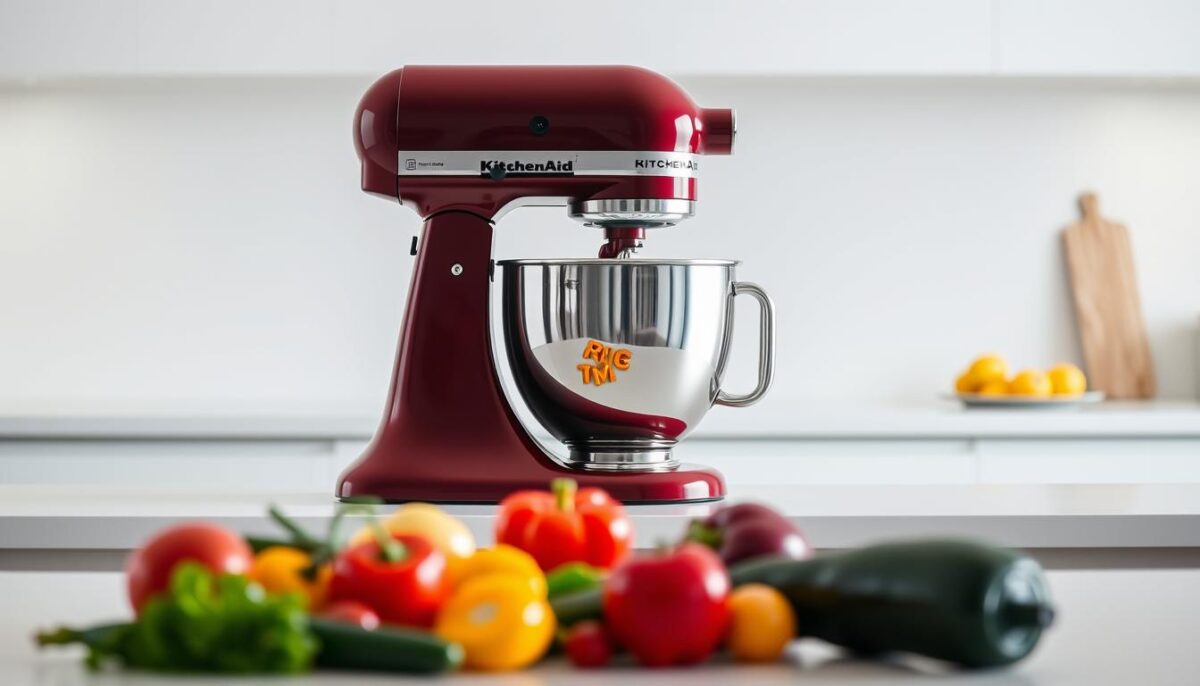
These specialty items not only enhance the menu but also provide opportunities for creative limited-time offerings and seasonal menu rotations, keeping the menu fresh and exciting for customers.
By incorporating KitchenAid equipment into their kitchen, restaurants can stay ahead of the curve, responding to customer preferences and trends with innovative menu items that showcase their culinary creativity.
Conclusion: Integrating KitchenAid into Your Restaurant Strategy
KitchenAid stand mixers are more than just kitchen tools; they are investments in a restaurant’s culinary vision and brand identity. By integrating these versatile mixers into their operations, restaurants can significantly enhance their menu offerings and operational efficiency.
To successfully integrate a KitchenAid stand mixer into a restaurant kitchen, it’s crucial to select the right model and train staff on its proper use. The benefits of implementation include labor savings, menu expansion, and improved quality control over food components. Starting with core stand mixer attachments and gradually expanding capabilities allows restaurants to adapt to customer feedback and menu development.
For restaurants of all sizes, from small cafes to full-service establishments, KitchenAid equipment can support unique culinary visions through distinctive house-made offerings. By leveraging KitchenAid stand mixers and attachments, restaurants can enhance menu development, operational efficiency, and brand differentiation. This strategic investment in kitchen equipment enables restaurants to remain adaptable in a changing industry landscape, ultimately driving customer interest with diverse flavors and high-quality food.
In conclusion, the right KitchenAid stand mixer and attachments can revolutionize a restaurant’s kitchen, supporting its brand identity and culinary goals. By focusing on the preparation of high-quality food and exploring various flavors, restaurants can create a memorable dining experience that sets them apart.
FAQ
What are the benefits of using a stand mixer in a commercial kitchen?
A stand mixer is a versatile tool that can help with a variety of tasks, from mixing and kneading dough to whipping cream and beating eggs. It’s a valuable addition to any commercial kitchen, saving time and labor while producing consistent results.
Can I make ice cream using my stand mixer?
Yes, with the right attachment, such as the KitchenAid Ice Cream Maker, you can create a variety of frozen treats, including ice cream, gelato, and sorbet.
How do I choose the right stand mixer for my restaurant’s needs?
Consider the size of your kitchen, the volume of your operations, and the types of dishes you prepare. A commercial-grade stand mixer is designed to withstand heavy use and can handle large batches of ingredients.
What are some essential attachments for a stand mixer in a restaurant kitchen?
Some must-have attachments include a dough hook for kneading bread dough, a wire whip for whipping cream and eggs, and a food grinder for processing meat and vegetables.
How do I maintain and clean my stand mixer to ensure optimal performance?
Regular cleaning and maintenance are crucial to extending the life of your stand mixer. Be sure to wipe down the exterior, clean the bowl and attachments, and check for worn or damaged parts.
Can I make a variety of desserts using my stand mixer?
Absolutely! From cakes and pastries to pies and ice cream cakes, a stand mixer is a valuable tool for creating a wide range of sweet treats. You can also experiment with different flavors and ingredients to develop unique desserts.
How can I optimize my stand mixer’s performance in a high-volume kitchen?
To maximize efficiency, consider using multiple attachments, such as a pasta maker or sausage stuffer, to streamline food preparation. You can also train your staff on proper equipment use to ensure they’re getting the most out of their stand mixer.
